Growing decorative almonds
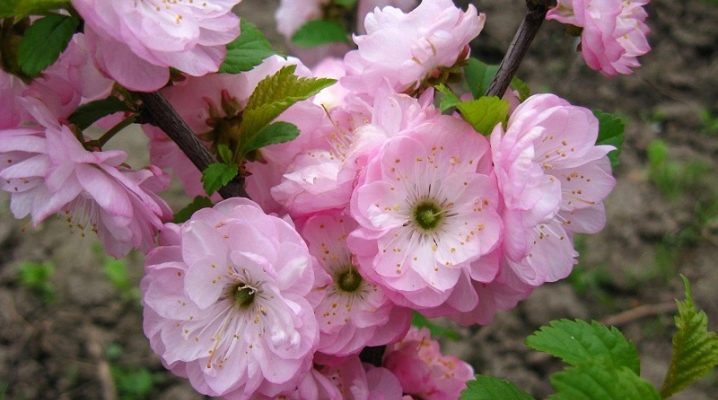
An almond is a bush or a small tree. Gardeners love it for its easy care and great looks. During flowering, the plant looks like sakura, all the branches of the bush are covered with pink flowers and look like a fairy ball, fireworks or a cloud, it all depends on the variety and method of cutting.
This article will focus on an ornamental plant with bitter fruit pits. Its cold resistance makes it possible to decorate gardens and parks of southern, central Russia and even some regions of Siberia with lush flowering shrubs.
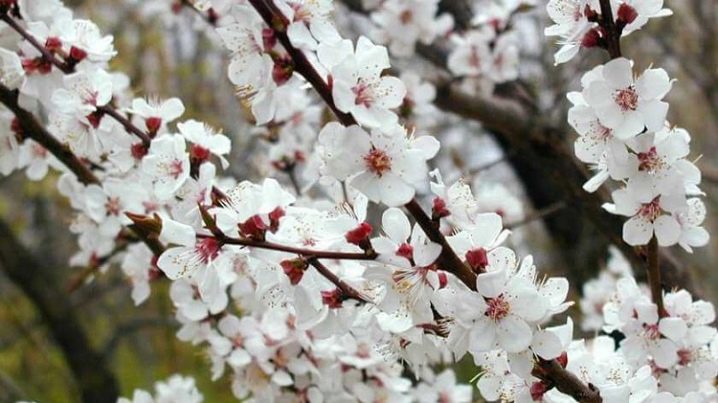
Description of the plant
Almonds (Prunus or Amygdalus) belong to the genus Prunus and the Rosaceae family. In nature, it grows in small groups of 3-4 bushes. Prefers calcium soils and well-lit areas. Resistant to drought, does not tolerate an abundance of moisture and spring frosts (if the growing season has already begun). In a sleeping state, it can withstand frosts down to -25 degrees. Almonds bloom in February, March or April, it all depends on the place of growth: the warmer the climate, the earlier the flowering will begin. The buds bloom at an air temperature of +8 degrees, and when the thermometer rises to +15 degrees, the tree is abundantly covered with flowers and pleases with its beauty for almost two weeks.
The plant lives up to 130 years, but its flowering age is limited by reproductive capabilities. It starts at 4 years old and ends at about 50 years old. In nature, almond bushes and trees are propagated by seeds or root shoots. Ornamental almonds grow in medium-sized bushes, sometimes gardeners arrange it on a trunk. The leaves of the plant are lanceolate, long, pointed at the ends. Most species acquire foliage after flowering, but there are exceptions, for example, steppe almonds release young greenery at the same time as flowers. The flowers are bisexual, single or collected in small brushes, they are simple or double, contain a large number of stamens.
The drupe is endowed with an inedible pericarp. Almonds are a misconception, a stone fruit is taken for a nut, which is sweet (edible) and bitter (inedible). The second variety contains toxic hydrocyanic acid and is used only in pharmacology. Sweet seeds are used in the food industry. The root system of the almond is powerful, allowing it to germinate on rocky soils, cling to slopes, and tolerate drought well.
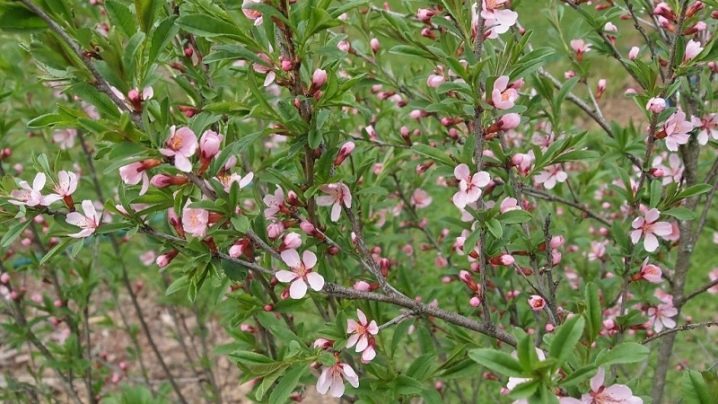
Types and varieties
Today, about 40 types of almonds are known, and no one counted the infinite number of varieties produced from them. Almonds grow wild in the Mediterranean, the Middle East, and Central Asia. The places of its growth are located at an altitude of 800 to 2000 m above sea level, it can often be seen on rocky mountain slopes. There are plantations of cultivated edible almonds in California, Spain, Portugal, Italy, Australia, Iran - wherever the climate permits.
On the basis of different types of almonds, many decorative varieties have been created, they are represented by both trees and shrubs. Thanks to selection, many varieties of almonds have acquired resistance to cold and now they feel great not only in warm countries, but also in central Russia. We propose to consider the types and varieties adapted to the regions of our country.
Ledebour
In the wild, frost-resistant shrub can still be found in the south-west of Altai. Ledebour grows to a height of 1.5-2 m. Unlike other varieties, it forms dense thickets. Contains large dark leaf plates and pink flowers. Flowering can be expected in May, it lasts for three weeks. Fruits begin to bear on the 10th year of life.
The most popular variety of this species is Fire Hill, it has deep pink flowers up to 3.5 cm in diameter.

Steppe
This species can be found in sources and under other names - wild almond, low, bean. It belongs to the dwarf variety of ornamental almonds. The plant does not grow more than 1.5 m, has a lush rounded crown with dense branches of a brownish shade. Blooms for two weeks in March-April. Here are the bean-based varieties.
- "Pink Mist". A medium-sized shrub, no more than two meters in height. Variety with relatively large flowers (25 mm), it blooms in May. If planted in an open, sunny place, you can expect abundant but short flowering. In partial shade it blooms longer, but more poorly.
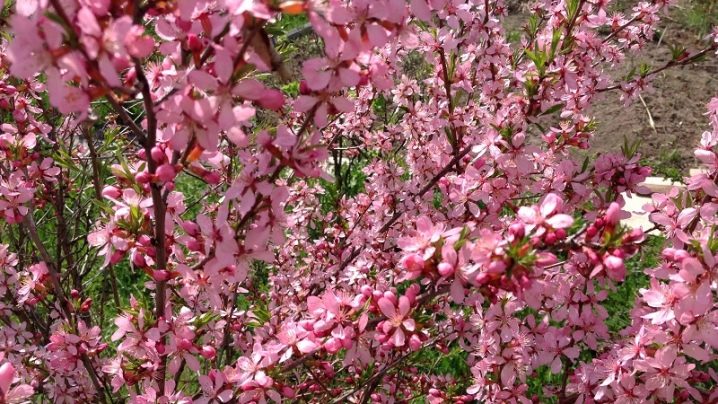
- "Anyuta". A low-growing shrub with even straight shoots, no more than 1.5 m high. The plant perfectly withstands drought, frost, grows on different soils, and is easy to form. The variety has simple and terry varieties and is often used in landscape designs.
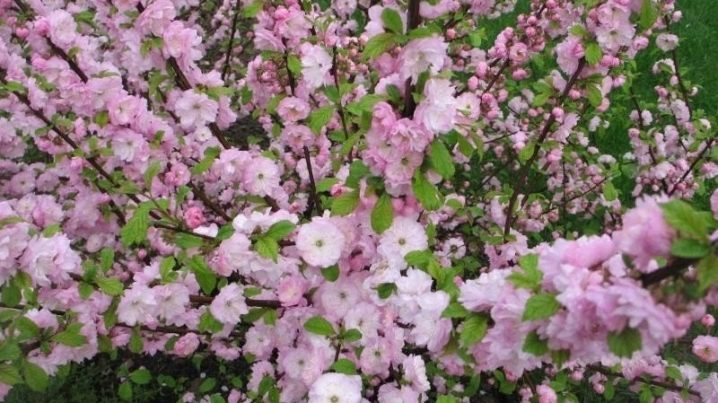
- "Pink flamingo". The most decorative variety with large and lush velvety flowers of deep pink color. It can grow more than two meters in height. Blooms in central Russia for several weeks in May.
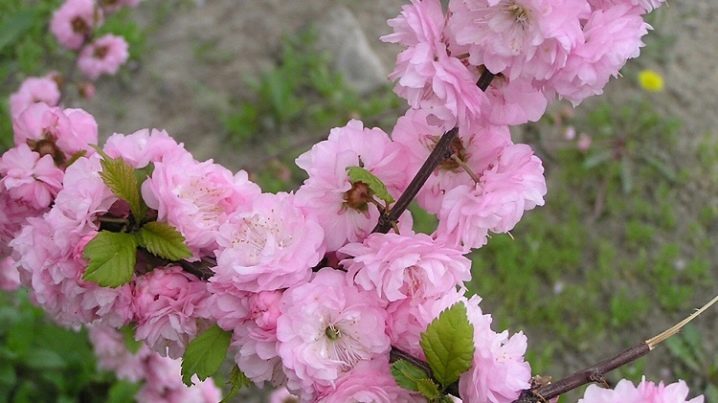
- "Dream". A beautiful variety rich in delicate colors. Often planted in the Moscow region, as the bushes are not afraid of frost. However, almonds suffer from drafts and extreme temperature fluctuations.
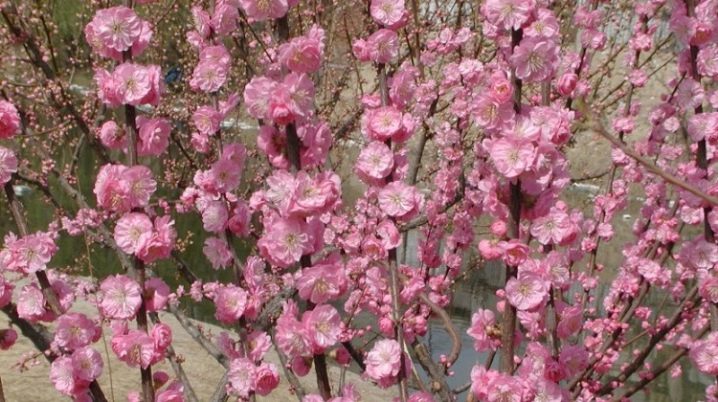
- "White Sail". An excellent terry variety with abundant flowering. In early May, almonds release snow-white flowers and are pleasing to the eye for 2-3 weeks. The variety is winter-hardy, but it is afraid of drafts.
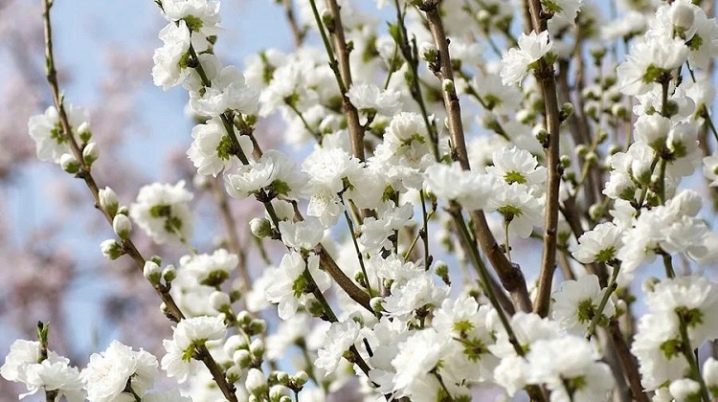
- "Mediator". The tree is more than two meters high. Blooms densely with large pale pink buds. The variety is not afraid of frost, withstands up to -38 degrees. Refers to hybrids (Mongolian legume with David's peach), created by Michurin at the beginning of the twentieth century. The task was to grow an intermediary that would help to breed a frost-resistant peach variety.

Three-bladed (Luiseania)
A bush 2.5-3 m high, with a spreading crown, is endowed with a high degree of decorativeness. Often used in landscape design. Due to the abundant flowering, the branches are not visible. The wide range of colors is surprising, here you can find cream, beige, pale pink, rich crimson shades of flowering bushes. The plant contains three-lobed leaf plates, like those of a plum, and large flowers - 35 mm. Often, Louiseania is formed into a standard version.
"Plena" is one of the first decorative varieties bred on the basis of three-bladed almonds. Has its own varieties, for example, "Prunus Rosea Plena" with pink flowers. "Alba Plena" forms a snow-white bloom. Simultaneously with flowering, leaves can be seen on the plant, which reduces the decorative effect of the bush. But the flowers themselves are endowed with the largest sizes for almonds - 40 mm. The fruits of "Plena" do not have time to ripen, they fall off in the stage of underdevelopment.
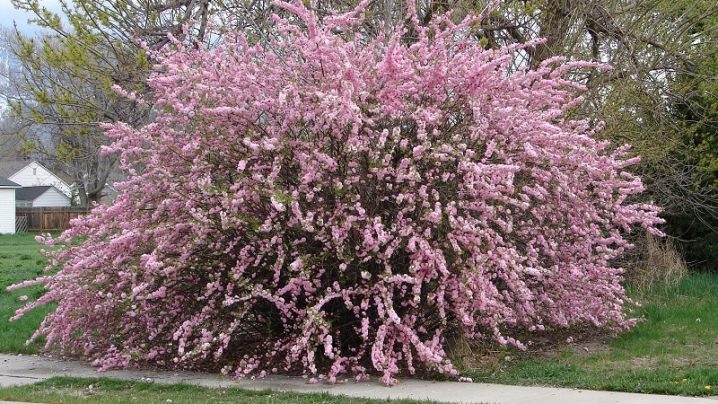
Luiseania Kievskaya is a lush shrub up to 3.5 m high, blooms with large double flowers even before the leaves appear, looks very decorative. This species has produced a large number of hybrids.
- "Tanyusha". A very beautiful bush created to decorate the park area. Each flower contains up to 40 petals and looks like a small peony bud. You can find plants with pale pink, crimson, almost beige shades of flowers.

- The Snows of Uimura. A compact bush with large whitish-pink flowers. At the moment of flowering, the petals change their tonality to a creamy-bodily shade.
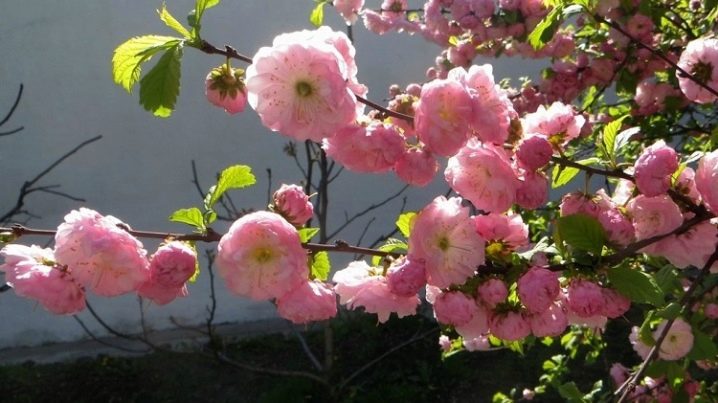
- "Chinese". The hybrid was obtained by grafting onto felt cherries, so it resembles sakura more than other species. And the fruits are similar to cherries, only much larger. The plant has erect branches strewn with bright pink flowers.
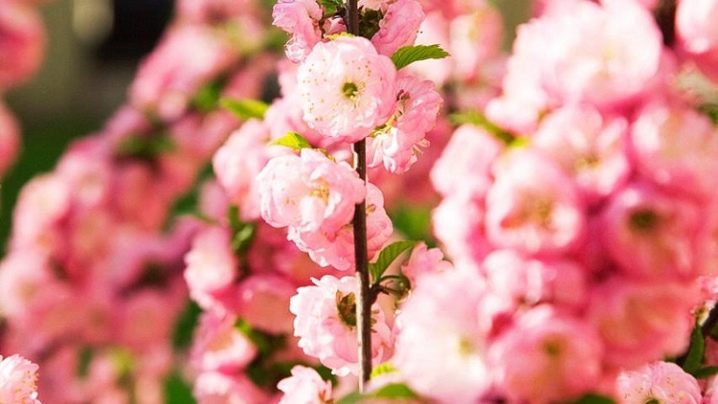
- "Svetlana". A hybrid of Ukrainian breeding with light pink petals. Has a simple and double flower varieties.
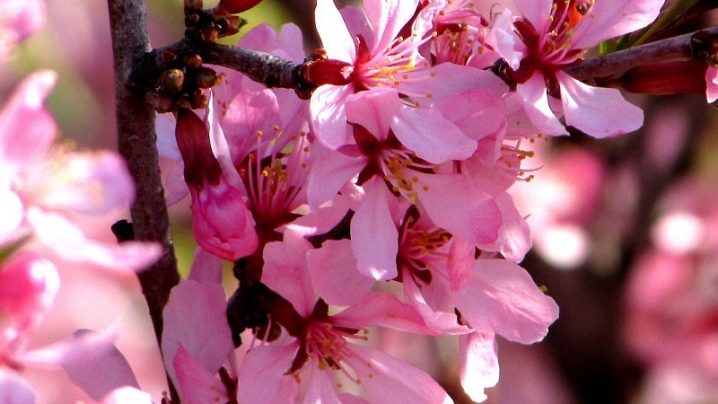
- Ruslana. It can be found in the form of a shrub or tree, the height is up to 3 m. The flowers are simple, 30 mm in diameter, but there are also terry varieties. Light beige with a pink tint, the color becomes white at the end of flowering. Blooms in April or May for two weeks.

- Vesnyanka. A three-meter tree with small light velvety flowers (20 mm), very resistant to diseases and severe frosts (up to -35 degrees). Blooms in May for 2-3 weeks.

- Rosenmund. A beautiful shrub up to 2.5 m in diameter with a spreading crown and straight branches. Blooms in April-May with deep pink flowers. The hybrid is frost-resistant.
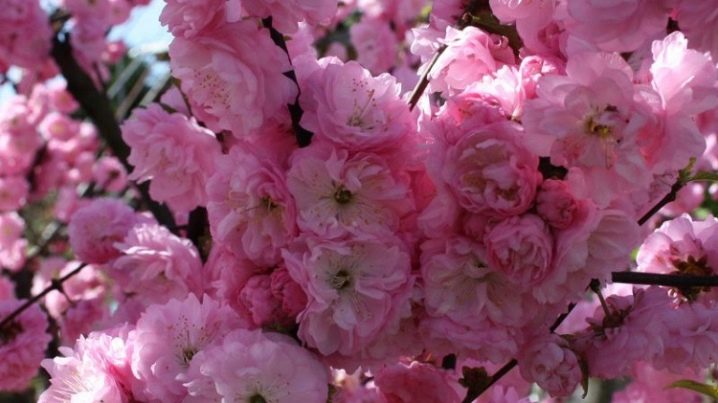
- "Crimson". A compact, elegant bush at the initial stage of flowering has a bright crimson color. As flowering approaches the last stage, the crimson hues begin to fade. The plant is found in the Primorsky Territory.
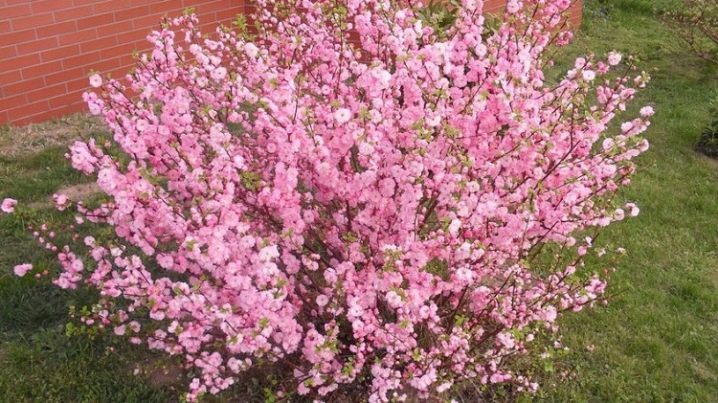
Georgian
A small bush with a height of one to one and a half meters grows on the sun-drenched slopes of the Caucasus Mountains. The first fruits with a bristly surface appear 7 years after planting. The splendor of the bush is provided by the root processes.
The plant is unpretentious to soil and frost, resistant to diseases and pests.
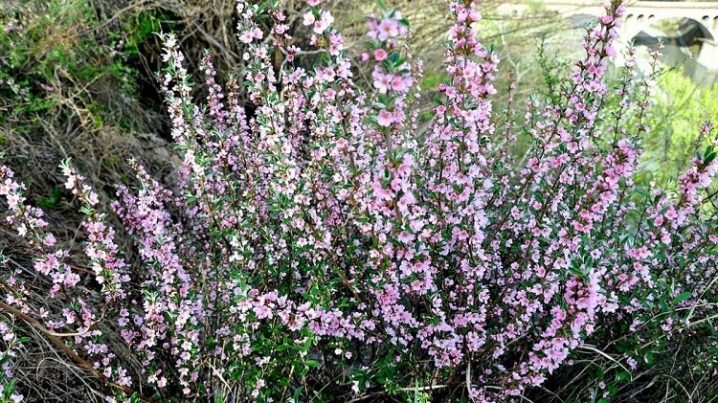
Petunnikova
A low-growing bush, reaches a height of no more than 80-100 cm. In the wild, it grows in dense thickets (almonds) on the stony hills of Central Asia. In our country, summer residents grow Petunnikov's almonds in the form of single plantings or in small groups. The plant loves warmth, one-year-old shoots can die from frost. Almonds of this variety bloom in the third year of life, begin to bear fruit in the fifth.
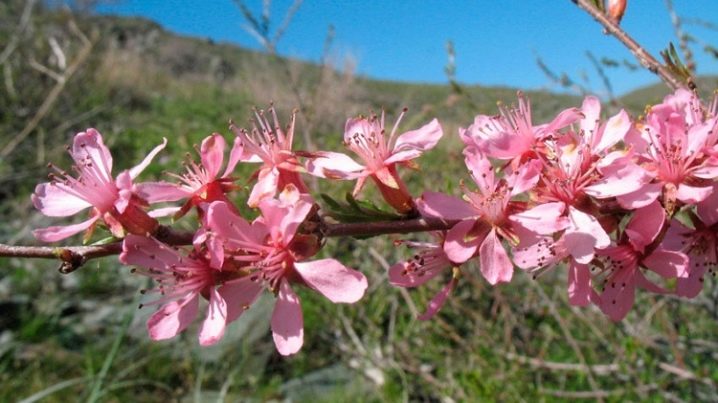
Dessert
An early frost-resistant type of almond, in the south of the country it blooms in April, in central Russia - in May. Begins to bear fruit in the third year of life. It has large oily fruits. The harvest from one plant is harvested at 8-10 kg.
An adult tree has a dense crown, it can grow up to 5 meters.
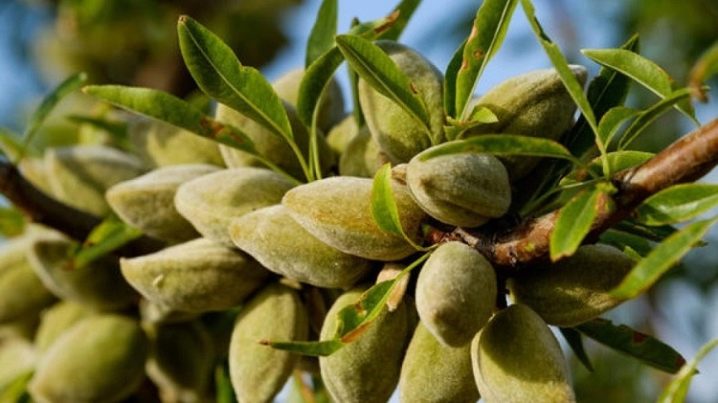
Landing
Many gardeners dream of planting almonds in their area. We will tell you in more detail how to do it correctly.
Site selection
When choosing a place in the garden, you should give preference to a sunny area, protected from wind and drafts. You can not plant a bush in a lowland or where groundwater is close to the surface, since the plant tolerates drought more easily than an abundance of moisture.
Ideal for an almond tree would be a sunny location on the south side of the garden, sheltered from the wind by buildings. But buildings should be located at a sufficient distance so that the plant does not appear in their shadow.
Timing
The planting time for almonds is in late autumn or early spring. When the foliage has already flown or has not yet appeared, the tree is in a calm state, it does not waste energy on the development of leaves, flowers, fruits. At this time, sap flow is slow, it is easier for the bush to endure the planting procedure.
Many gardeners prioritize autumn planting over spring planting, believing that the tree has time to settle down before awakening, to get cold hardening, and in spring to be saturated with moisture from melted snow.

Soil and pit preparation
In nature, almonds grow on rocky or calcareous slopes, on light loamy or sandy loamy soils. It would be nice to reproduce similar conditions at the planting site of the seedling. Despite the fact that the plant is unpretentious in the choice of soil, heavy clay and acidic soils negatively affect its development and growth. If on your site the soil has a similar composition, you need to work on it by adding sand.It will make the soil looser, more airy. Dolomite flour and lime will help reduce acidity.
The planting hole is dug two weeks before planting the almonds. The depth and diameter of the excavation is usually 50-70 cm. Humus, sand and 400 g of dolomite mineral are laid out at the bottom of the depression. Sprinkle with fertile soil with decayed leaves. After a few weeks, all the components will combine into a single substrate, then you can start planting the plant.
Disembarkation process
When the place is selected and the pit is prepared, planting the seedling in open ground occurs in the following way.
- Drainage (pebbles, broken brick, crushed stone) is laid on the bottom of the groove with a layer of 10 cm and sprinkled with nutritious soil. Drainage removes excess moisture, preventing the root system from rotting.
- A small peg is driven into the center of the hole - this is a support to help the plant.
- The seedling is placed in the recess together with an earthen lump. If the root system is open, a few hours before planting, it is placed in water diluted with clay.
- The seedling is covered with earth so that the root collar remains outside, otherwise the plant will hurt and will not be able to develop.
- Then the soil around the trunk is slightly compacted, watered and mulched with peat.
- At the last stage, the seedling is neatly tied to a support, but loosely, giving it the opportunity to develop.
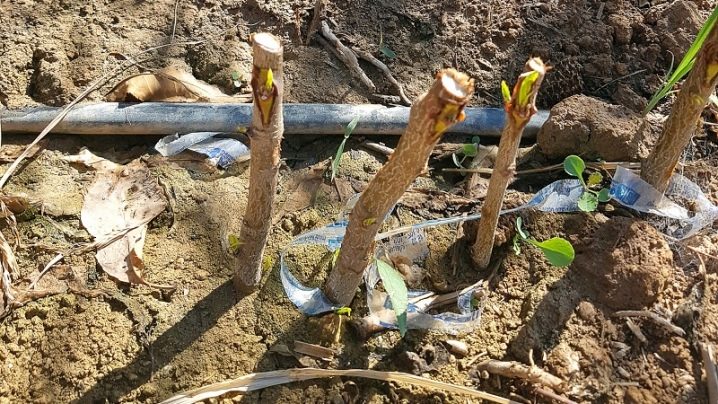
Care
Almonds are no more difficult to care for than any other garden shrub. Periodically, it needs to be watered, weeds are weeded nearby, cut and fed. Let's consider the stages of leaving in more detail.
Watering
The plant tolerates drought well and does not need frequent watering, it is enough to pour 15-20 liters of water under each bush 3 times a month. At the time of budding, you can water more often, but not much. This will help maintain the rich color of the bush throughout the flowering period. Do not forget to loosen the soil before watering, remove weeds, and after watering, mulch the soil in the near-trunk circle.
Top dressing
You can feed the almond bush according to the following scheme.
- In the spring. Immediately after the snow melts, the soil around the plant is enriched with compost and low-lying peat. Before budding, together with water (10 l), a mixture of nitrate (40 g), urea (25 g) and mullein (1 l) is introduced into the soil.
- Summer. In July, fertilizers containing potassium, calcium and phosphorus are used. They help strengthen the woody parts of the plant and set buds for the next year's almond blossom.
- In the autumn. During the digging of the site, superphosphate is introduced into the soil.

Pruning
Ornamental almonds are incredibly beautiful during flowering. They are used to decorate adjoining territories, squares, summer cottages. In order for the crown to grow not spontaneously, but to form into a spectacular ball, the plant needs a haircut. Almond bushes are pruned in stages.
- In the spring, diseased and damaged parts of the plant are removed. Thin out the shoots, leaving some of the strongest shoots.
- In the summer, after flowering, a bush or tree is provided with a decorative haircut, forming a crown in the form of a ball, a dome.
- At the beginning of autumn or at the end of summer, the apical buds are cut off so that they do not freeze out.
- After 7-8 years, the tree is rejuvenated by pruning old branches. Places of cuts are lubricated with clay or fungicide.
Reproduction
There are different ways to breed ornamental almonds. But it should be understood that varietal varieties do not propagate by seeds, they often have sterile forms and simply do not have time to ripen. For them, cuttings are used. Species variants of almonds reproduce in any way, including seed.
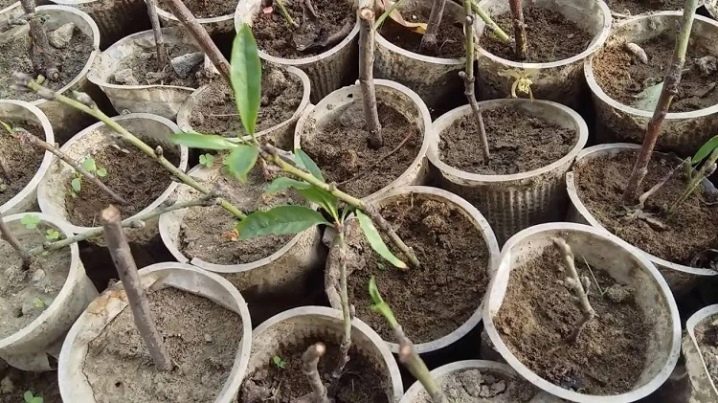
Growing from seeds
Freshly picked seeds germinate well, but you can also use purchased almonds that have not been heat treated. You need to work with seeds for germination in several stages.
- First, the nuts must be stratified. To do this, they are kept in the refrigerator for 40-50 days.
- Then the bones need to be helped to hatch. To do this, they are placed on a napkin in a plate and poured with settled water for a day.Approximately in the middle of the term, the water is changed, and the seeds are washed. At this point, if the almonds are in the shell, they should be slightly chipped, but not removed.
- After a day, the nuts will hatch and will be ready for planting.
- For planting seeds, take a small container. The seeds are buried 3 cm in the soil, point upwards, moistened. It is better to use 5-10 seeds, since not all of them will germinate.
- The box is covered with foil and placed on the windowsill for 5-6 weeks, awaiting germination.
- When the sprouts appear, the film is removed.
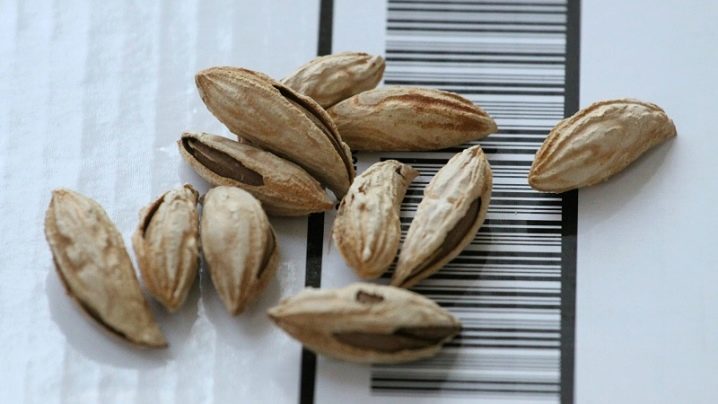
Cuttings
Cuttings are harvested in mid-July. For these purposes, choose the lateral lignified branches of young bushes with 2-3 nodes. By the time of planting the material, a loose substrate of sand and peat is prepared (1: 2). Disinfect it with a manganese solution. The cuttings are kept for 10 minutes in a growth stimulator, and then immersed in the substrate up to the upper bud with a thick cut down. A box with planting material is sent to the windowsill, covered with a film to create a special microclimate.
Watering is carried out several times a day. You should wait for rooting at least 1.5-2 months, then you can transplant the cuttings into a large box or immediately into open ground for growing. In addition to seed propagation and cuttings, other breeding methods are also used: by layering, young shoots, by dividing the bush. Almonds are also grafted onto a stock grown from the seeds of plum, cherry plum, peach, and blackthorn.
Diseases and pests
Almonds are most susceptible to fungal diseases.
- Root and gray rot appear from dampness in dark places. Infected plant parts should be cut and destroyed.
- Moniliosis. Branches and young shoots are affected by spores; in a neglected case, the plant dries up completely. The bush at the time of the disease is treated with copper sulfate every two weeks.
- Rust. Fungal lesions appear as spots on the underside of the leaves. They are treated with fungicides, sulfur powder.
Of the pests, spider mites, almond seed eaters, aphids and leafworms should be wary. They use "Kleschevit", "Agravertin" against them.
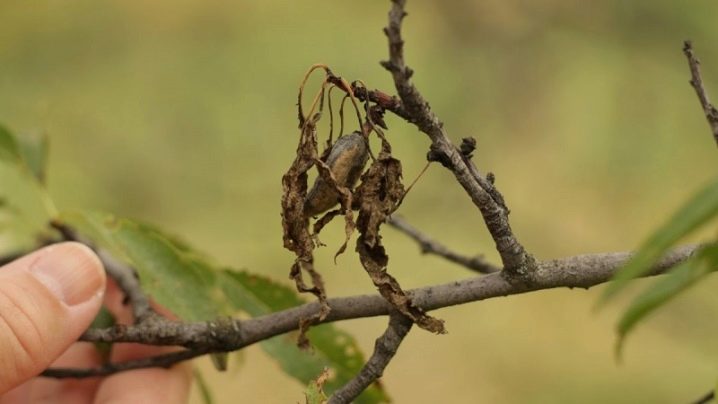
Use in landscape design
Almonds look amazing during flowering, which is why they are often used for bright accent images of the garden:
- single bushes of pink or crimson color look especially impressive against the background of a fresh green lawn;
- in the recreation area among the almond trees, you can feel the comfort and atmosphere of romance;
- the best decoration for garden and park paths are trees on boles with spherical crowns of delicate pink shades;
- almonds go well with coniferous vegetation, garden boulders, with a contrasting tone of other shrubs.
In the landscape, designers most often turn to low-growing varieties with double flowers, in which leaves appear after abundant flowering.
On a selection of examples, you can be convinced of the high decorativeness of almond bushes and trees.
- Three-lobed almonds, shaped by a tree, planted along the paths.
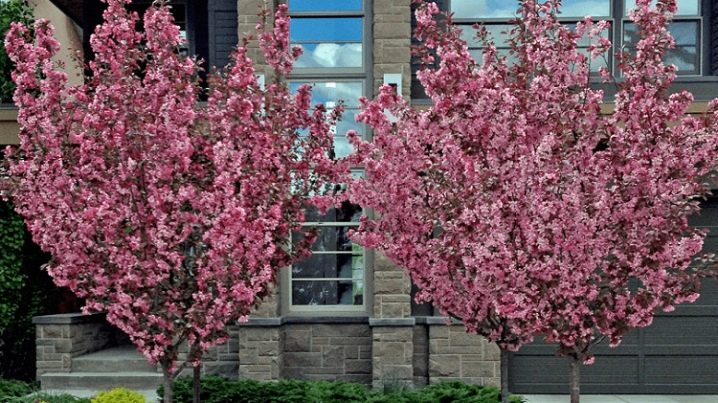
- Blooming thickets, placed on a green lawn.
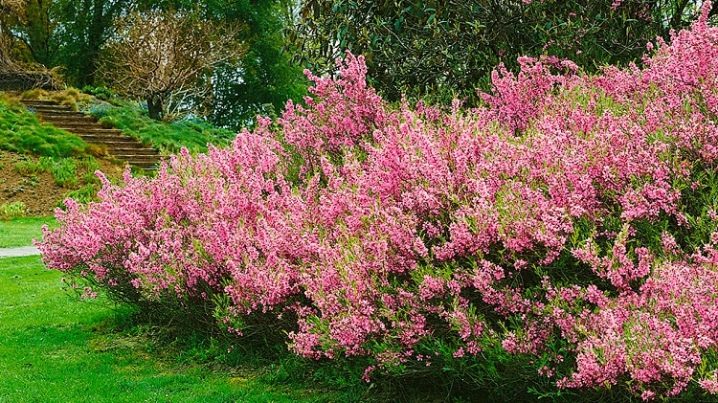
- The almonds on the stem are used in the design of the garden.
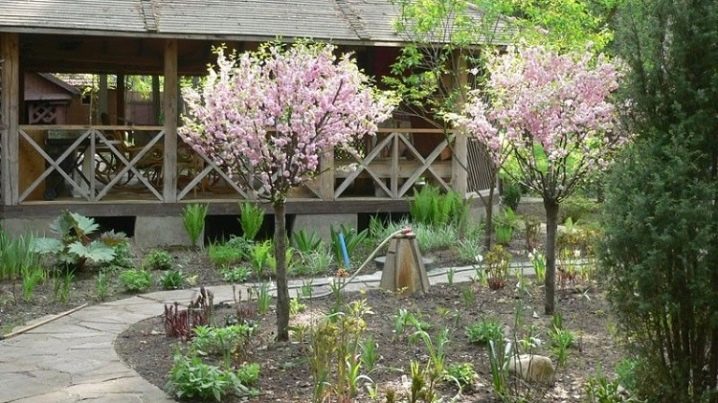
- An adult flowering tree is located in the center of the flower bed.
To decorate courtyards, gardens and squares, a large number of decorative varieties of almonds have been bred, which will satisfy any designer's idea. But even wild species, spontaneously planted by the owners, can become a real decoration of any site.
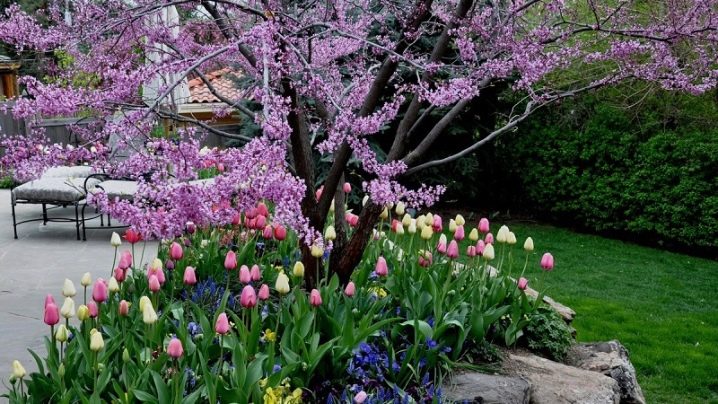







The comment was sent successfully.